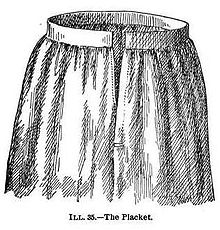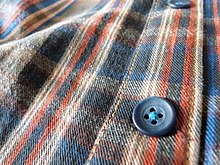Placket

Illustration of a placket, or opening, made in the upper part of a petticoat or skirt for convenience in putting it on

A shirt placket with buttons and topstitching on top
A placket (also spelled placquet) is an opening in the upper part of trousers or skirts, or at the neck or sleeve of a garment.[1] Plackets are almost always used to allow clothing to be put on or removed easily, but are sometimes used purely as a design element. Modern plackets often contain fabric facings or attached bands to surround and reinforce fasteners such as buttons, snaps, or zippers.
Contents
1 Construction
2 Variations
3 In historical clothing
4 References
5 Further reading
Construction
In modern usage, the term placket often refers to the double layers of fabric that hold the buttons and buttonholes in a shirt. Plackets can also be found at the neckline of a shirt, the cuff of a sleeve, or at the waist of a skirt or pair of trousers.
Plackets are almost always made of more than one layer of fabric, and often have interfacing in between the fabric layers. This is done to give support and strength to the placket fabric because the placket and the fasteners on it are often subjected to stress when the garment is worn. The two sides of the placket often overlap. This is done to protect the wearer from fasteners rubbing against their skin and to hide underlying clothing or undergarments.
Variations
A button-front shirt without a separate pieced placket is called a "French placket."[2] The fabric is simply folded over and the buttonhole stitching secures the two layers (or three layers if there is an interlining). This method affords a very clean finish, especially if heavily patterned fabrics are being used. This method is normally only used in stiff-fronted formal evening ("white-tie") shirts. However, the normal, separate placket on a shirt gives a more symmetrical appearance.
If the buttons are concealed by a separate flange or flap of the shirting fabric running the length of the placket, it is called a "fly front." The inner placket of a fly front shirt can be made as a less constructed French placket or as a fully constructed regular placket.[citation needed]
In historical clothing
Historically, a placket may also be:
- A decorative front-panel used to fill in the opening of a doublet or gown (later called a stomacher). Also spelled placard.[3]
- A decorative panel or "forepart" (see 1500–1550 in Fashion) attached to a woman's petticoat.[4]
- An opening or slit in a skirt or petticoat to access a separate, hanging pocket.[5]
- A petticoat or skirt pocket.[1]
References
^ ab Picken, Mary Brooks (1957). The Fashion Dictionary. Funk and Wagnalls..mw-parser-output cite.citationfont-style:inherit.mw-parser-output .citation qquotes:"""""""'""'".mw-parser-output .citation .cs1-lock-free abackground:url("//upload.wikimedia.org/wikipedia/commons/thumb/6/65/Lock-green.svg/9px-Lock-green.svg.png")no-repeat;background-position:right .1em center.mw-parser-output .citation .cs1-lock-limited a,.mw-parser-output .citation .cs1-lock-registration abackground:url("//upload.wikimedia.org/wikipedia/commons/thumb/d/d6/Lock-gray-alt-2.svg/9px-Lock-gray-alt-2.svg.png")no-repeat;background-position:right .1em center.mw-parser-output .citation .cs1-lock-subscription abackground:url("//upload.wikimedia.org/wikipedia/commons/thumb/a/aa/Lock-red-alt-2.svg/9px-Lock-red-alt-2.svg.png")no-repeat;background-position:right .1em center.mw-parser-output .cs1-subscription,.mw-parser-output .cs1-registrationcolor:#555.mw-parser-output .cs1-subscription span,.mw-parser-output .cs1-registration spanborder-bottom:1px dotted;cursor:help.mw-parser-output .cs1-ws-icon abackground:url("//upload.wikimedia.org/wikipedia/commons/thumb/4/4c/Wikisource-logo.svg/12px-Wikisource-logo.svg.png")no-repeat;background-position:right .1em center.mw-parser-output code.cs1-codecolor:inherit;background:inherit;border:inherit;padding:inherit.mw-parser-output .cs1-hidden-errordisplay:none;font-size:100%.mw-parser-output .cs1-visible-errorfont-size:100%.mw-parser-output .cs1-maintdisplay:none;color:#33aa33;margin-left:0.3em.mw-parser-output .cs1-subscription,.mw-parser-output .cs1-registration,.mw-parser-output .cs1-formatfont-size:95%.mw-parser-output .cs1-kern-left,.mw-parser-output .cs1-kern-wl-leftpadding-left:0.2em.mw-parser-output .cs1-kern-right,.mw-parser-output .cs1-kern-wl-rightpadding-right:0.2em
^ atailoredsuit.com Men's Dress Shirts - A Deeper Understanding of Custom Shirts Accessed 30 December 2010.
^ A New Variorum Edition of Shakespeare : King Lear. 1880 FLORIO gives: "Tarace, . . . also a placket or a stomacher, a brestplate or corselet for the body." This led SINGER and others to define it simply as "a stomacher."
^ John Stephen Farmer, William Ernest Henley. Placket (or Plackethole), p221, Slang and Its Analogues Past and Present. 1902.
^ Virginia Ralston. When Mother Lets Us Sew—Making a Placket, p37. Moffat, Yard and company, 1910.
Further reading
Mikhaila, Ninya (2006). The Tudor Tailor: reconstructing sixteenth-century dress. Costume & Fashion Press. ISBN 0-89676-255-6.
